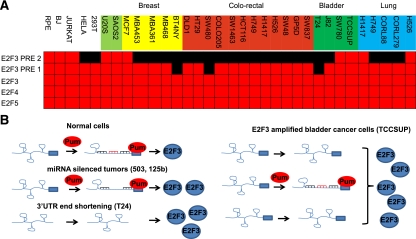Figure 7.
3′ End shortening of E2F3 is widespread in cancer cell lines. (A) 3′ RACE analysis of E2F3 (PRE 2, PRE 1, and E2F3), E2F4, and E2F5 from primary cells (RPE and BJ) and representative sarcoma, breast, colorectal, bladder, and lung cancer cell lines. A gene-specific primer and an amplification primer were used in a first-round amplification step. Purified 3′ RACE products were then used in a second round of PCR using a different gene-specific primer. Amplicons were designed to map key regulatory regions within each 3′ UTR, including PREs and miRNA clusters. Red boxes indicate sequence detected in transcripts, and black boxes represent absence sequence. (B) Model of Pum and miRNA regulation of E2F3 translation. In normal cells, the E2F3 3′ UTR is highly structured. Interaction of Pumilio with the PRE sequences facilitates the relaxing of the secondary structure, enabling miRNAs to gain access to their seed sequences and regulate E2F3 protein levels. In tumors that have selectively silenced miRNAs that cooperate with Pumilio (miR-503 or miR-125b), translation control is weakened and more protein is produced. In cells that have shortened their 3′ UTRs (T24), no PRE sequences remain and the E2F3 transcript is rapidly translated, producing elevated levels of E2F3 protein. In cancer cells that amplify the E2F3 locus (TCCSUP), the elevated levels of transcript exceed the capacity of Pumilio regulation, and only a subset of transcripts are regulated. The remainder is rapidly translated.

